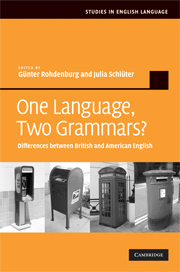Book contents
- Frontmatter
- Contents
- List of figures
- List of tables
- List of contributors
- Introduction
- 1 Colonial lag, colonial innovation or simply language change?
- 2 Compound verbs
- 3 The formation of the preterite and the past participle
- 4 Synthetic and analytic comparatives
- 5 Phonology and grammar
- 6 Prepositions and postpositions
- 7 Argument structure
- 8 Reflexive structures
- 9 Noun phrase modification
- 10 Nominal complements
- 11 Non-finite complements
- 12 The present perfect and the preterite
- 13 The revived subjunctive
- 14 The mandative subjunctive
- 15 The conditional subjunctive
- 16 Tag questions
- 17 The pragmatics of adverbs
- 18 How different are American and British English grammar? And how are they different?
- 19 New departures
- Bibliography
- Index
6 - Prepositions and postpositions
Published online by Cambridge University Press: 03 July 2009
- Frontmatter
- Contents
- List of figures
- List of tables
- List of contributors
- Introduction
- 1 Colonial lag, colonial innovation or simply language change?
- 2 Compound verbs
- 3 The formation of the preterite and the past participle
- 4 Synthetic and analytic comparatives
- 5 Phonology and grammar
- 6 Prepositions and postpositions
- 7 Argument structure
- 8 Reflexive structures
- 9 Noun phrase modification
- 10 Nominal complements
- 11 Non-finite complements
- 12 The present perfect and the preterite
- 13 The revived subjunctive
- 14 The mandative subjunctive
- 15 The conditional subjunctive
- 16 Tag questions
- 17 The pragmatics of adverbs
- 18 How different are American and British English grammar? And how are they different?
- 19 New departures
- Bibliography
- Index
Summary
Introduction
The present chapter covers a hitherto neglected area of word-order variation involving the syntactic rivalry between post- and prepositions in English. By comparing the distribution in BrE and AmE, it contributes to the underlying purpose of the book, which is to discern discrepancies and similarities in the grammars of both varieties. Since word-order differences between BrE and AmE are rarely mentioned in the literature, a brief survey will suffice.
A case in point is the positioning of adverbs that are associated with complex predicates (auxiliary + main verb). Empirical research done by Jacobson (1975: 155–225) on ten years of selected American newspapers in the late 1960s reveals that AmE allows for more than 20 per cent of preposed adverbial usage, as in (1). BrE, by contrast, uses the adverb in mid-position, as illustrated in (2) in 96 per cent of all cases (see Britt Sandberg's newspaper data from 1969 in Jacobson 1981: 89–93).
The search already has cost Shell $9 million in the offshore area. (Jacobson 1975: 166)
The boycott has already cost the state as much as $20 million … (Guardian 92)
Further research on word-order variation includes split negative infinitives as in (3), which again occur far more often in AmE than in BrE, where the standard contiguous placement, as in (4), is still the clearly preferred variant (see Chapter 19 by Rohdenburg and Schlüter; for the use of the split infinitive in AmE, see also Fitzmaurice 2000, Kato 2001).
- Type
- Chapter
- Information
- One Language, Two Grammars?Differences between British and American English, pp. 130 - 148Publisher: Cambridge University PressPrint publication year: 2009
- 2
- Cited by



